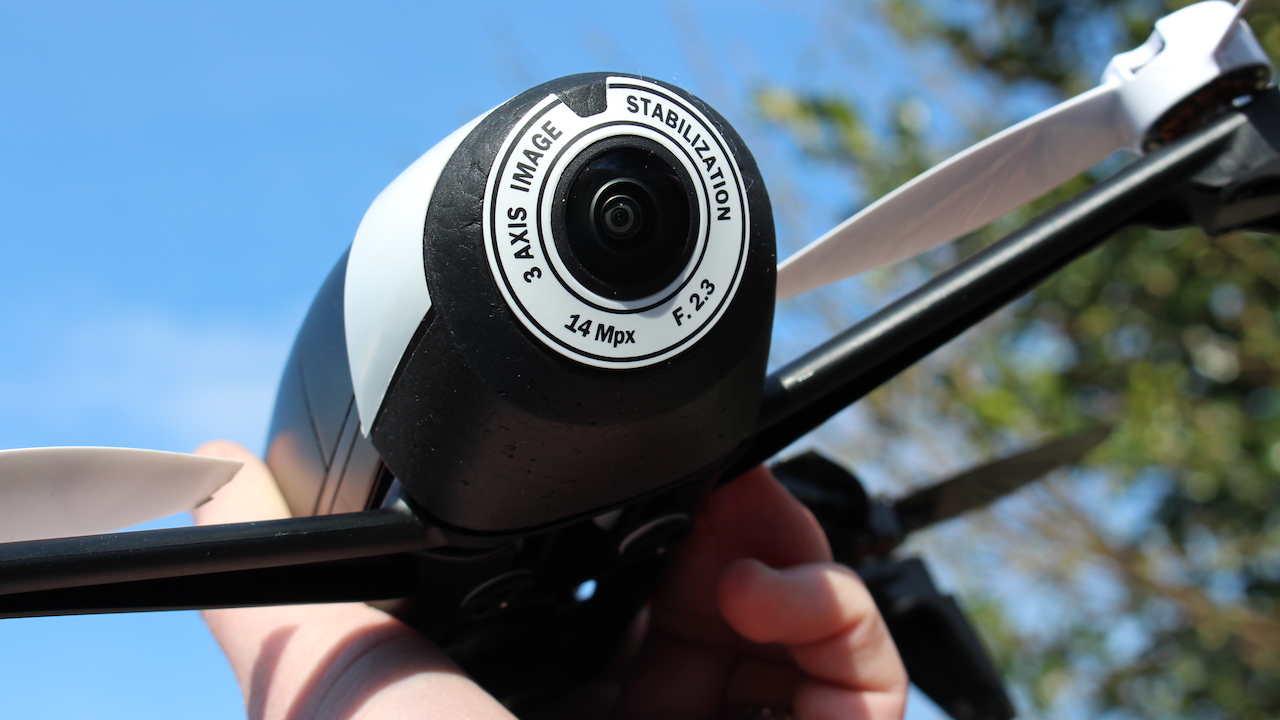TechRadar Verdict
On its own the Parrot Bebop 2 is a likeable smartphone-controlled drone that captures good-quality stills and video, but it's the addition of the FPV kit which really makes it stand out, offering a better control experience and an amazing perspective on the world from above.
Pros
- +
Great battery life
- +
Stable flight performance
- +
FPV accessories work well
Cons
- -
Video is glitchy at long distances
- -
Fisheye camera suffers from lens flare
- -
Autonomous functions cost extra
Why you can trust TechRadar
The Parrot Bebop 2 is a smartphone-controlled drone with a 14-megapixel camera which offers 1080p video recording. The successor to the original Parrot Bebop model, it features a fisheye lens which allows for surprisingly judder-free footage and even boasts user-serviceable rotors.
The USP of the Bebop 2 is the optional FPV pack, which includes a headset and professional-style flight controller, complete with sticks and buttons. Using this setup it's possible to get a first-person view of what the drone is actually seeing, which is a surprisingly immersive experience.
- The best drones: DJI, Parrot and more for pros and beginners
The catch is that, when you add the cost of the FPV pack to the price of the Bebop 2 itself, you're rapidly approaching the kind of sum you'd normally expect to splash on a more capable drone.
Price and availability
The Parrot Bebop 2 is available on its own for £439.99 / $549.99 / AU$649 direct from the manufacturer, although you can pick it up for less from third-party retailers. That price gets you just the drone itself, so you'll need to use a compatible smartphone as a controller. Alternatively, you can pick up the Bebop 2 FPV bundle, which includes the drone, the Parrot Skycontroller 2 and Parrot Cockpitglasses headset for £599.99 / $699.99 / AU$949.99.
Design
You'd be forgiven for assuming that the Bebop 2 is modest upgrade over the original Bebop, purely down to the fact that they look so similar. Thankfully, Parrot hasn't been that lazy; the Bebop 2 boasts a more robust design and a larger-capacity battery, addressing two of the big problems with the first Bebop.

The bodywork is now almost entirely plastic, save for some deformable polystyrene-type material around the camera. Each rotor has three blades, and these can be removed when the drone isn't in use. The massive 2700mAh battery slots onto the back of the unit itself, and has to be detached for charging.
Build and handling
The Bebop 2's design is unique in that it's not a single solid unit, but two main elements which are connected via a series of shock-absorbing rubber balls. The main body – which houses the camera and electronics, and onto which the battery clips – sits on top of these balls, and they reduce the impact of vibration on the camera itself.
Sign up for breaking news, reviews, opinion, top tech deals, and more.

While the Bebop 2 feels a little flimsy in the hand as a result of this design, it means video recording is less prone to shake from the powerful rotors on each arm.
The plastic rotors are removable, and have to be fitted to the drone itself using a special tool. The rotors are colour-coded – white for the front, black for the back – and have to be fitted to the correct arm before flying. There's a spare set of rotors in the box, and it's possible to order replacements if they get damaged. In fact, much of the unit is modular – it's possible to buy new motor units for the arms, too.

The Bebop 2's motors are pretty powerful, and it's able to hold its position even when being buffeted by relatively strong winds. Take-off and landing are easy, and the unit is clever enough to know when there's an issue which could cause problems – for example, if you try to take off in long grass that catches one of the rotors, the motors will turn off and you'll get an error message until you move the drone to a clear space. Some other drones, like the ZeroTech Dobby, lack this feature, and can flip over as a result, potentially causing damage.
When the drone's in the air there's a small amount of drift in positioning, but unless you're in a really cramped space – which is never recommended when flying a drone – it's not too much of an issue. The Bebop 2 is fast and responsive when airborne, and is capable of some surprisingly swift turns.
Current page: Introduction, design, build and handling
Next Page Performance, video capture and FPV kit